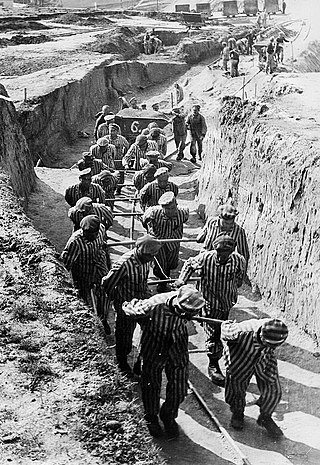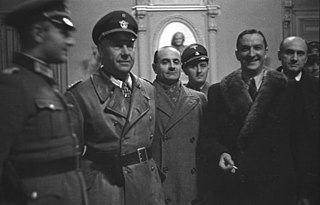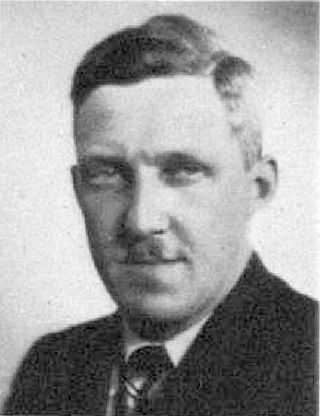
Ernst Kaltenbrunner was a high-ranking Austrian SS official during the Nazi era and a major perpetrator of the Holocaust. After the assassination of Reinhard Heydrich in 1942, and a brief period under Heinrich Himmler, Kaltenbrunner was the third Chief of the Reich Security Main Office (RSHA), which included the offices of Gestapo, Kripo and SD, from January 1943 until the end of World War II in Europe.

The Schutzstaffel was a major paramilitary organisation under Adolf Hitler and the Nazi Party in Nazi Germany, and later throughout German-occupied Europe during World War II.
Sicherheitsdienst, full title Sicherheitsdienst des Reichsführers-SS, or SD, was the intelligence agency of the SS and the Nazi Party in Nazi Germany. Established in 1931, the SD was the first Nazi intelligence organization and the Gestapo was considered its sister organization through the integration of SS members and operational procedures. The SD was administered as an independent SS office between 1933 and 1939. That year, the SD was transferred over to the Reich Security Main Office, as one of its seven departments. Its first director, Reinhard Heydrich, intended for the SD to bring every single individual within the Third Reich's reach under "continuous supervision".

Mauthausen was a Nazi concentration camp on a hill above the market town of Mauthausen, Upper Austria. It was the main camp of a group with nearly 100 further subcamps located throughout Austria and southern Germany. The three Gusen concentration camps in and around the village of St. Georgen/Gusen, just a few kilometres from Mauthausen, held a significant proportion of prisoners within the camp complex, at times exceeding the number of prisoners at the Mauthausen main camp.

From 1933 to 1945, Nazi Germany operated more than a thousand concentration camps, including subcamps on its own territory and in parts of German-occupied Europe.

Heinrich Müller was a high-ranking German Schutzstaffel (SS) and police official during the Nazi era. For most of World War II in Europe, he was the chief of the Gestapo, the secret state police of Nazi Germany. Müller was central in the planning and execution of the Holocaust and attended the January 1942 Wannsee Conference, which formalised plans for deportation and genocide of all Jews in German-occupied Europe—The "Final Solution to the Jewish Question". He was known as "Gestapo Müller" to distinguish him from another SS general named Heinrich Müller.

German Earth and Stone Works was an SS-owned company created to procure and manufacture building materials for state construction projects in Nazi Germany. DEST was a subsidiary company of Amtsgruppe W of SS Main Economic and Administrative Office (WVHA). Both Amt. W and the WVHA were headed by Waffen-SS generals Oswald Pohl and Georg Lörner.

The Sicherheitspolizei, often abbreviated as SiPo, was a term used in Germany for security police. In the Nazi era, it referred to the state political and criminal investigation security agencies. It was made up by the combined forces of the Gestapo and the Kriminalpolizei between 1936 and 1939. As a formal agency, the SiPo was incorporated into the Reich Security Main Office (RSHA) in 1939, but the term continued to be used informally until the end of World War II in Europe.

The Dachau trials, also known as the Dachau Military Tribunal, handled the prosecution of almost every war criminal captured in the U.S. military zones in Allied-occupied Germany and in Allied-occupied Austria, and the prosecutions of military personnel and civilian persons who committed war crimes against the American military and American citizens. The war-crime trials were held within the compound of the former Dachau concentration camp by military tribunals authorized by the Judge Advocate General of the U.S. Third Army.

August Eigruber was an Austrian-born Nazi Gauleiter and Reichsstatthalter of Reichsgau Oberdonau and Landeshauptmann of Upper Austria. He was convicted of war crimes at Mauthausen-Gusen concentration camp and hanged.
Reinhardt's fund was a group of Nazi German bank accounts where money and valuables stolen from concentration and death camp victims were kept. The money was used to finance a number of Nazi construction projects, including the construction of new concentration camps.

Austria was part of Nazi Germany from 13 March 1938 until 27 April 1945, when Allied-occupied Austria declared independence from Nazi Germany.
The Steyr-Münichholz concentration camp was one in a number of subcamps of the Mauthausen-Gusen concentration camp in Upper Austria. Inmates were drawn from the main camp, in order to exploit their labor for producing arms in Steyr-Daimler-Puch corporation factories, and to build air-raid bunkers in the town of Steyr.

The Mühlviertler Hasenjagd was a war crime in which 500 Soviet officers, who had revolted and escaped from the Mühlviertel subcamp of Mauthausen-Gusen concentration camp on 2 February 1945, were hunted down. Local civilians, soldiers and local Nazi organizations hunted down the escapees for three weeks, summarily executing most of them. Of the original 500 prisoners who took part in the escape attempt, eleven succeeded in remaining free until the end of the war. It was the largest escape in the history of the Nazi concentration camps.
Rudolf Mildner was an Austrian-German SS-Standartenführer. He served as the chief of the Gestapo at Katowice and was the head of the political department at Auschwitz concentration camp, conducting "third degree" methods of interrogation from March 1941 until September 1943. As such, he frequently sent prisoners to Auschwitz for incarceration or execution. He visited Auschwitz on several occasions. In December 1944, he was appointed chief of the SiPo, Gestapo and SD in Vienna. After the war, Mildner testified at the Nuremberg Trials and remained in custody until 1949.

Hans Maršálek was an Austrian typesetter, political activist, detective, historian, and suspected spy for the Soviet Union. A devout socialist and active in the resistance, he was arrested by the Nazis and imprisoned in the Mauthausen concentration camp. After the war, he joined the Austrian political police and was instrumental in tracking down and convicting numerous Nazi criminals. He also became the main chronicler of the camp's history, helped establish the Mauthausen Memorial Museum, and published several books.

Granitwerke Mauthausen was one of the names used by the DEST company for its branch based in Sankt Georgen an der Gusen and which exploited the slave manpower confined in certain subcamps of the Mauthausen-Gusen concentration camp system: Gusen I, Gusen II, Gusen III, and Mauthausen.

Gusen was a subcamp of Mauthausen concentration camp operated by the SS between the villages of Sankt Georgen an der Gusen and Langestein in the Reichsgau Ostmark. Primarily populated by Polish prisoners, there were also large numbers of Spanish Republicans, Soviet citizens, and Italians. Initially, prisoners worked in nearby quarries, producing granite which was sold by the SS company DEST.
The Holocaust in Austria was the systematic persecution, plunder and extermination of Jews by German and Austrian Nazis from 1938 to 1945. Part of the wider-Holocaust, pervasive persecution of Jews was immediate after the German annexation of Austria, known as the Anschluss. An estimated 70,000 Jews were murdered and 125,000 forced to flee Austria as refugees.














